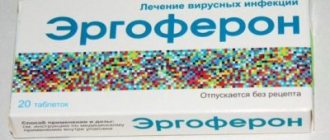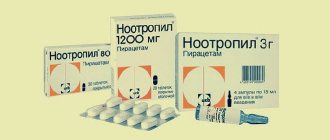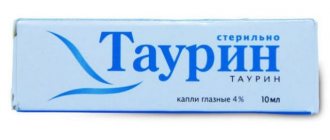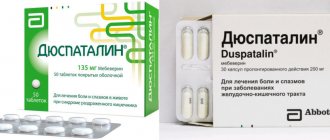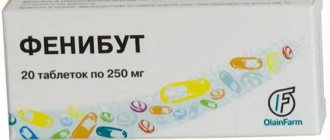An antiviral drug that is a specific inhibitor of DNA polymerase of herpes viruses is Valtrex. Instructions for use indicate that 500 mg tablets block viral replication and viral DNA synthesis. Gynecologists indicate that the medicine helps in the treatment of oral and genital herpes, as well as cytomegalovirus infection.
Release form, composition and packaging
White film-coated tablets, biconvex, oblong, without a score, with the inscription “VALTREX 500” printed on one side in blue ink; The tablet core is white or almost white.
| 1 tab. | |
| valacyclovir hydrochloride | 556 mg, |
| incl. valacyclovir | 500 mg |
Excipients: microcrystalline cellulose, crospovidone, povidone K90, magnesium stearate, colloidal anhydrous silicon, carnauba wax, white dye concentrate; Printing ink containing Brilliant Blue 5312 (FT203).
10 pieces. - blisters (1) - cardboard packs. 6 pcs. - blisters (7) - cardboard packs.
Composition of the drug
The active ingredient of the drug is valacyclovir. Its amount in each tablet is 500 mg.
To give the medicine the appropriate form, additional components are included in it, among which are:
- povidone;
- silica;
- microcrystalline cellulose;
- magnesium stearate;
- wax;
- crospovidone.
The product may also contain a small amount of ink.
Valtrex is packaged in blisters of 10 pieces.
Before you use this medicine, you need to find out what it helps with. To do this, you need to study the instructions or ask a doctor. You should not start treatment with it yourself, since it has contraindications. You need to make sure that the use of Valtrex is advisable - this is the only way to avoid unpleasant consequences.
pharmachologic effect
Antiviral drug. In the human body, valacyclovir is quickly and completely converted to acyclovir under the influence of valacyclovir hydrolase.
Acyclovir in vitro has specific inhibitory activity against Herpes simplex viruses types 1 and 2, Varicella zoster and Epstein-Barr, cytomegalovirus and human herpes virus type 6. Acyclovir inhibits the synthesis of viral DNA immediately after phosphorylation and conversion to the active form of acyclovir triphosphate. The first stage of phosphorylation occurs with the participation of virus-specific enzymes. For Herpes simplex, Varicella zoster and Epstein-Barr viruses, this enzyme is viral thymidine kinase, which is present in cells affected by the virus. Partial phosphorylation selectivity is conserved in cytomegalovirus and is mediated through the phosphotransferase gene product UL 97. Activation of acyclovir by a specific viral enzyme largely explains its selectivity.
The process of phosphorylation of acyclovir (conversion from mono-to triphosphate) is completed by cellular kinases. Acyclovir triphosphate competitively inhibits viral DNA polymerase and, being a nucleoside analogue, is incorporated into viral DNA, which leads to obligate (complete) chain breakage, cessation of DNA synthesis and, consequently, blocking viral replication.
In patients with preserved immunity, Herpes simplex and Varicella zoster viruses with reduced sensitivity to valacyclovir are extremely rare (less than 0.1%), but can sometimes be detected in patients with severe immune disorders, for example, with a bone marrow transplant, in those receiving chemotherapy for malignant diseases. neoplasms and in HIV-infected people.
Resistance is caused by a deficiency of the virus' thymidine kinase, which leads to excessive spread of the virus in the host. Sometimes a decrease in sensitivity to acyclovir is due to the emergence of virus strains with a violation of the structure of the viral thymidine kinase or DNA polymerase. The virulence of these variants of the virus resembles that of the wild strain.
Pharmacokinetics
Valacyclovir and acyclovir have similar pharmacokinetic parameters after oral administration.
Suction
After oral administration, valacyclovir is well absorbed from the gastrointestinal tract and is quickly and almost completely converted to acyclovir and valine. This transformation is catalyzed by the enzyme valacyclovir hydrolase, isolated from human liver.
After a single dose of 0.25-2 g of valacyclovir, the Cmax of acyclovir in healthy volunteers with normal renal function averages 10-37 µmol (2.2-8.3 µg/ml), and the median time to reach this concentration is 1-2 hours.
When taking valacyclovir in a dose of 1 g, the bioavailability of acyclovir is 54% and does not depend on food intake.
The Cmax of valacyclovir in plasma is only 4% of the concentration of acyclovir and is achieved on average 30-100 minutes after taking the drug; after 3 hours, the Cmax level remains the same or decreases.
Distribution
The degree of binding of acyclovir to plasma proteins is very low - 15%.
Removal
In patients with normal renal function, T1/2 of acyclovir is approximately 3 hours. Valacyclovir is excreted in the urine, mainly in the form of acyclovir (more than 80% of the dose) and its metabolite 9-carboxymethoxymethylguanine, less than 1% of the drug is excreted unchanged.
Pharmacokinetics in special clinical situations
In patients with end-stage renal failure, T1/2 of acyclovir is approximately 14 hours.
The pharmacokinetics of valacyclovir and acyclovir are not significantly affected in patients infected with Herpes simplex and Varicella zoster viruses.
In late pregnancy, the steady-state daily AUC after taking 1 g of valacyclovir was approximately 2 times greater than that when taking acyclovir at a dose of 1.2 g/day.
Taking Valtrex at a dose of 1 g and 2 g does not affect the distribution and pharmacokinetic parameters of valacyclovir in HIV-infected patients compared to healthy individuals.
In organ transplant recipients receiving valacyclovir at a dose of 2 g 4 times / day, the Cmax of acyclovir is equal to or greater than that in healthy volunteers receiving the same dose of the drug, and their daily AUC values are significantly higher.
Chemistry of medicine
One dose contains 556 mg of valacyclovir hydrochloride, which is similar to 0.5 g of valacyclovir - that is, a therapeutic dose. Soon after taking the drug in food, the active compound is absorbed through the walls of the stomach and intestines. In the circulatory system, under the influence of liver enzymes, the substance is transformed into acyclovir, valine. The first is excreted from the body in urine. The half-life of acyclovir from blood plasma is estimated at three hours if the kidneys are functioning normally; if the activity of this organ is weakened, the period can reach 14 hours.
The active components show a pronounced effect on the first, second and sixth types of herpetic virus, as well as cytomegalovirus, smallpox and the Epstein-Barr virus. The active compound inhibits the processes of viral DNA synthesis by a phosphorylation reaction, during which acyclovir triphosphate is produced.
Soon after valacyclovir is absorbed into the circulatory system, the component is distributed to organs and tissues. Only a small percentage of the drug binds to plasma proteins.
VALTREX: DOSAGE
For the treatment of herpes zoster, adults are prescribed 1 g 3 times a day for 7 days.
For the treatment of diseases caused by the Herpes simplex virus, adults are prescribed Valtrex 500 mg 2 times a day. In case of relapse, treatment should be carried out for 3 or 5 days. In more severe primary cases, treatment should be started as early as possible, and its duration should be increased from 5 to 10 days. In case of relapses of the disease, it is considered optimal to prescribe Valtrex in the prodromal period or immediately after the appearance of the first symptoms of the disease.
As an alternative for the treatment of labial herpes (labial fever), the administration of Valtrex at a dose of 2 g 2 times for 1 day is effective. The second dose should be taken approximately 12 hours (but not earlier than 6 hours) after taking the first dose. With this dosing regimen, the duration of treatment should not exceed 1 day, as it does not provide additional clinical benefits. Therapy should begin when the earliest symptoms of lip fever (ie, tingling, itching, burning) appear.
For the prevention (suppression) of recurrent infections caused by the Herpes simplex virus, adults with normal immunity levels are prescribed a dose of 500 mg 1 time / day. For adults with immunodeficiency, it is recommended to prescribe 500 mg 2 times a day.
Duration of treatment is 4-12 months.
To prevent infection of a healthy partner with genital herpes in heterosexual adult patients with preserved immunity and with the number of exacerbations up to 9 per year, Valtrex should be prescribed 500 mg 1 time / day for a year or more every day with regular sexual intercourse; for irregular sexual intercourse, Valtrex should be prescribed must be started 3 days before expected sexual intercourse.
There are no data on infection prevention in other patient populations.
For the prevention of cytomegalovirus infection in adults and adolescents over 12 years of age, the recommended dose is 2 g 4 times a day. The drug is prescribed as soon as possible after transplantation. The dose should be reduced depending on the QC. The duration of the course is 90 days, but can be increased in patients with a high risk of developing infections.
In case of renal failure, the dosage regimen is set depending on creatinine clearance and indications.
For patients on hemodialysis, it is recommended to prescribe Valtrex immediately after the end of the hemodialysis session at a dose intended for patients with CC less than 15 ml/min. The drug should be used after the end of the hemodialysis session.
For the prevention of cytomegalovirus infections, Valtrex is recommended to be prescribed in the following doses.
For patients on hemodialysis, Valtrex should be prescribed after the end of the hemodialysis session.
Frequent monitoring of CK is necessary, especially during periods when renal function changes rapidly (including immediately after transplantation or engraftment); The dose of Valtrex should be adjusted according to QC.
Indications Creatinine clearance Dose of Valtrex Herpes zoster 15-30 ml/min 1 g 2 times/day less than 15 ml/min 1 g 1 time/day Treatment of infections caused by Herpes simplex less than 15 ml/min 500 mg 1 time/day Treatment of labial herpes 31-49 ml/min 1 g 2 times for 1 day 15-30 ml/min 500 mg 2 times/day for 1 day less than 15 ml/min 500 mg once Prevention (suppression) of infections caused by Herpes simplex less 15 ml/min with normal immunity: 250 mg 1 time/day with immunodeficiency: 500 mg 1 time/day To reduce infection with genital herpes less than 15 ml/min 250 mg 1 time/day Creatinine clearance (ml/min) Valtrex dose ≥75 2 g 4 times/day 50-1.5 g 4 times/day 25-1.5 g 3 times/day 10-1.5 g 2 times/day 1.5 g 1 time/day
Instructions for use
Before starting treatment with this remedy, you should consult a specialist. Due to contraindications, this drug can harm the patient, so self-medication is not allowed. You also need to know how to take these pills correctly.
The medicine is intended for oral administration. It does not matter when the patient takes Valtrex - before or after meals - it does not affect the results. You only need to take into account that the tablets should not be chewed or crushed.
The course of treatment and dosage are selected individually. This is influenced by the diagnosis, the degree of neglect of the pathology, concomitant diseases, characteristics of the immune system, etc. Therefore, it is difficult to independently decide on a consumption schedule.
General recommendations are as follows: for herpes zoster, the daily dosage of the drug is 1 g. This amount should be divided into 3 doses. The duration of treatment is a week. If a patient is diagnosed with herpes, he should be treated for 5 days, taking 250 mg tablets twice a day.
But the dosage regimen and duration of the treatment course can be changed if necessary. Sometimes the dose of medication is increased.
Video from an expert:
Overdose
Currently, there is insufficient data on Valtrex overdose.
Symptoms: with a single oral dose of acyclovir in an excessive dose of up to 20 g, partial absorption from the gastrointestinal tract occurred, which was not accompanied by a toxic effect of the drug. Ingestion of acyclovir in excessive doses for several days was accompanied by gastrointestinal (nausea, vomiting) and neurological symptoms (headache, confusion). Excessive doses of intravenous acyclovir have been associated with increased serum creatinine levels and subsequent development of renal failure, with neurological complications including confusion, hallucinations, agitation, seizures and coma.
Treatment: Patients should be under close medical supervision for signs of toxicity. Hemodialysis significantly enhances the removal of acyclovir from the blood and can be considered the method of choice in the management of patients with an overdose of Valtrex.
Drug interactions
There are no clinically significant interactions between Valtrex and other drugs.
Acyclovir is excreted in the urine mainly unchanged as a result of active tubular secretion. After taking Valtrex at a dose of 1 g, cimetidine and probenecid, which block tubular secretion, increase the AUC of acyclovir and reduce its renal clearance. However, no dose adjustment of Valtrex is required, because acyclovir has a wide therapeutic index.
It is necessary to use Valtrex with caution in higher doses (4 g/day) simultaneously with drugs that compete with acyclovir for the elimination pathway, because there is a risk of increased plasma levels of one or both drugs or their metabolites. An increase in the AUC of acyclovir and the inactive metabolite mycophenolate mofetil (an immunosuppressant used in transplantation) was observed when these drugs were administered concomitantly.
Caution must be exercised when combining Valtrex in a high dose (4 g/day or higher) with drugs that impair renal function (including cyclosporine, tacrolimus).
Valtrex or Valacyclovir - which is better?
Valacyclovir is a substitute for Valtrex. They have similar effects because they are based on the same substance.
Both drugs have an antiviral effect and can be used to eliminate herpes, chicken pox, and shingles.
Valaciclovir is also available in tablets, they contain the same amount of active substance, so there is no fundamental difference between the drugs.
These drugs differ only in cost - Valtrex is one of the expensive drugs, while Valaciclovir is an affordable drug.
Pregnancy and lactation
There are limited data on the use of Valtrex during pregnancy. Valtrex is used only in cases where the potential benefit to the mother outweighs the possible risk to the fetus.
Reported data on pregnancy outcomes in women taking Valtrex or Zovirax (acyclovir is the active metabolite of valaciclovir) did not show an increase in the number of birth defects in their children compared with the general population. Since the registry included a small number of women who took valacyclovir during pregnancy, reliable and definite conclusions about the safety of valacyclovir during pregnancy cannot be made.
Acyclovir, the main metabolite of valacyclovir, is excreted in breast milk. After oral administration of valacyclovir at a dose of 500 mg, the Cmax of acyclovir in breast milk was 0.5-2.3 times (on average 1.4 times) higher than the corresponding concentrations of acyclovir in maternal blood plasma. The ratio of AUC of acyclovir found in breast milk to AUC of acyclovir in maternal plasma ranged from 1.4 to 2.6 (mean value 2.2). The average concentration of acyclovir in breast milk was 2.24 μg/ml (9.95 μg/M). When the mother takes valacyclovir orally at a dose of 500 mg 2 times a day, the child will be exposed to the same effects of acyclovir as when taken orally at a dose of about 0.61 mg/kg/day. T1/2 of acyclovir from breast milk is the same as from blood plasma. Valaciclovir unchanged was not detected in maternal plasma, breast milk or child urine.
Considering this, Valtrex should be prescribed with caution to mothers during lactation (breastfeeding). However, intravenous administration of Zovirax at a dose of 30 mg/kg/day is used in newborns to treat diseases caused by the herpes simplex virus.
In experimental studies, valacyclovir did not have a teratogenic effect in rats and rabbits. SC administration of acyclovir did not cause teratogenic effects in rats and rabbits in conventional teratogenicity tests. In additional studies on rats, fetal developmental disorders were identified with subcutaneous administration of the drug in doses that caused an increase in the plasma concentration of acyclovir to 100 mcg/ml and toxic effects in the mother.
When administered orally, valacyclovir did not cause fertility problems in male or female rats.
Price
The drug is available in pharmacy chains and online pharmaceutical stores. The cost may vary from different sellers depending on their pricing policy. The approximate price for Valtrex is:
| Concentration, mg | Number of tablets, pcs. | Minimum price | Maximum price |
| 500 | 10 | 1188 | 1350 |
| 42 | 3290 | 3400 |
VALTREX: SIDE EFFECTS
Adverse reactions are listed below according to the classification by main systems and organs and by frequency of occurrence: very often (≥1/10), often (≥1/100,
From the side of the central nervous system: often - headache.
From the digestive system: often - nausea.
Post-marketing data
From the immune system: very rarely - anaphylaxis.
From the side of the central nervous system: rarely - dizziness, confusion, hallucinations, decreased mental abilities; very rarely - agitation, tremor, ataxia, dysarthria, psychotic symptoms, convulsions, encephalopathy, coma.
These reactions are reversible and are usually observed in patients with impaired renal function or against the background of other predisposing conditions. In patients with a transplanted organ receiving Valtrex in high doses (8 g/day) for the prevention of cytomegalovirus infection, neurological reactions develop more often than when taken in lower doses.
From the respiratory system: infrequently - dyspnea.
From the digestive system: rarely - abdominal discomfort, vomiting, diarrhea; very rarely - reversible abnormalities in liver function tests (which are sometimes regarded as manifestations of hepatitis).
From the hematopoietic system: very rarely - leukopenia (mainly observed in patients with reduced immunity), thrombocytopenia.
Dermatological reactions: infrequently - rash, manifestations of photosensitivity; rarely - itching.
Allergic reactions: very rarely - urticaria, angioedema.
From the urinary system: rarely - renal dysfunction; very rarely - acute renal failure, renal colic (may be associated with impaired renal function).
Others: In patients with severely immunocompromised patients, especially those with advanced AIDS, receiving valacyclovir in high doses (8 g/day daily) for a long time, cases of renal failure, microangiopathic hemolytic anemia and thrombocytopenia (sometimes in combination) have been observed. Similar adverse reactions have been observed in patients with the same diseases, but not receiving valacyclovir.
Indications
- treatment of herpes zoster,
- caused by the Varicella zoster virus (accelerates the disappearance of pain,
- reduces its duration and the percentage of patients with pain,
- including acute and postherpetic neuralgia);
- treatment of skin and mucous membrane infections,
- caused by the Herpes simplex virus types 1 and 2 (including newly diagnosed and recurrent genital herpes);
- treatment of labial herpes (labial fever);
- Valtrex is able to prevent the formation of lesions,
- if taken when the first symptoms of relapse of herpes simplex appear;
- prevention (suppression) of relapses of diseases of the skin and mucous membranes,
- caused by Herpes simplex virus types 1 and 2,
- including genital herpes;
- Valtrex can reduce genital herpes infection in a healthy partner,
- if taken as a suppressive therapy in combination with safe sex;
- prevention of cytomegalovirus infection,
- occurring during organ transplantation (reduces the severity of acute graft rejection in patients with kidney transplants,
- development of opportunistic infections and other viral infections,
- caused by Herpes simplex and Varicella zoster viruses).
Contraindications
Valtrex is prescribed with caution in cases of renal failure, in combination with nephrotoxic medications, and in clinically manifest forms of the human immunodeficiency virus (HIV infection). Direct contraindications to the immunomodulator are:
- severe cirrhosis of the liver;
- age up to 12 years;
- increased susceptibility to the components of the composition;
- age up to 18 years, subject to treatment of herpes zoster or the ophthalmic form of herpes zoster.
special instructions
Patients at risk of dehydration, especially elderly patients, must ensure adequate hydration of the body during treatment with Valtrex.
Patients with renal failure have an increased risk of developing neurological complications.
In case of liver dysfunction in patients with mild or moderate liver cirrhosis (the synthetic function of the liver is preserved), no dose adjustment of Valtrex is required. When studying pharmacokinetics in patients with severe liver cirrhosis (with impaired synthetic function of the liver and the presence of shunts between the portal system and the general vascular bed), there was also no data indicating the need for correction of the dosage regimen; however, clinical experience with the use of Valtrex in this category of patients is limited.
There is no data on the use of Valtrex in high doses (4 g/day or more) in patients with liver disease, so the drug should be prescribed with caution in high doses to this category of patients.
Elderly patients do not require dose adjustment, except in cases of significant impairment of renal function. It is necessary to maintain adequate water and electrolyte balance.
No special studies have been conducted to study the effect of Valtrex in patients undergoing liver transplantation. However, prophylactic administration of high doses of acyclovir has been shown to reduce cytomegalovirus infection.
Suppressive therapy with Valtrex reduces the risk of transmission of genital herpes, but does not completely eliminate it and does not lead to a complete cure. During therapy with Valtrex, the patient must take measures to ensure the safety of the partner during sexual intercourse.
Use in pediatrics
There is no experience of clinical use of the drug in children.
Impact on the ability to drive vehicles and operate machinery
No special precautions are required.
Use for renal impairment
In case of renal failure, the dosage regimen is set depending on creatinine clearance and indications.
For patients on hemodialysis, it is recommended to prescribe Valtrex immediately after the end of the hemodialysis session at a dose intended for patients with CC less than 15 ml/min. The drug should be used after the end of the hemodialysis session.
For the prevention of cytomegalovirus infections, Valtrex is recommended to be prescribed in the following doses.
For patients on hemodialysis, Valtrex should be prescribed after the end of the hemodialysis session.
Frequent monitoring of CK is necessary, especially during periods when renal function changes rapidly (including immediately after transplantation or engraftment); The dose of Valtrex should be adjusted according to QC.
Indications Creatinine clearance Dose of Valtrex Herpes zoster 15-30 ml/min 1 g 2 times/day less than 15 ml/min 1 g 1 time/day Treatment of infections caused by Herpes simplex less than 15 ml/min 500 mg 1 time/day Treatment of labial herpes 31-49 ml/min 1 g 2 times for 1 day 15-30 ml/min 500 mg 2 times/day for 1 day less than 15 ml/min 500 mg once Prevention (suppression) of infections caused by Herpes simplex less 15 ml/min with normal immunity: 250 mg 1 time/day with immunodeficiency: 500 mg 1 time/day To reduce infection with genital herpes less than 15 ml/min 250 mg 1 time/day Creatinine clearance (ml/min) Valtrex dose 75 or more than 2 g 4 times/day 50 - less than 75 1.5 g 4 times/day 25 - less than 50 1.5 g 3 times/day 10 - less than 25 1.5 g 2 times/day less than 10 or dialysis 1.5 g 1 time/day
Nuances of use
The price, reviews, and instructions for Valtrex attract the attention of many, since the product is considered effective when used correctly. It is necessary to take into account certain restrictions, which both doctors and the manufacturer draw attention to in the accompanying documentation. For example, the drug can be used in old age, but in case of severe renal impairment, the dosage will have to be adjusted.
If the patient is on hemodialysis, the medication is prescribed in a dose similar to CC less than 15 ml/min. The manufacturer advises using the tablets immediately after hemodialysis.
There is no information on the use of the drug in people under the age of twelve.
Use for liver dysfunction
In case of liver dysfunction in patients with mild or moderate liver cirrhosis (the synthetic function of the liver is preserved), no dose adjustment of Valtrex is required. When studying pharmacokinetics in patients with severe liver cirrhosis (with impaired synthetic function of the liver and the presence of shunts between the portal system and the general vascular bed), there was also no data indicating the need for correction of the dosage regimen; however, clinical experience with the use of Valtrex in this category of patients is limited.
There is no data on the use of Valtrex in high doses (4 g/day or more) in patients with liver disease, so the drug should be prescribed with caution in high doses to this category of patients.
Rules of use
The tablets can be used at a convenient time, without reference to meals. It is recommended to drink plenty of clean water with a portion of the drug. The dosage regimen and duration of the therapeutic course are determined by the doctor, based on the diagnosis, the patient’s condition, background pathologies, and characteristics of the body. In this case, follow the instructions for use of Valtrex. Reviews claim that when used correctly, the drug has a pronounced and rapid effect.
For viral diseases caused by herpes simplex, the optimal course of treatment for adults is:
- twice a day;
- single dosage – 500 mg;
- duration – five days.
If the disease begins severely, the maximum effect will be achieved by timely initiation of therapy. If necessary, the course can be extended to ten days. If the disease is prone to relapse, each new episode requires 3-5 days of treatment. Valtrex should be taken at the prodromal stage or immediately, as soon as the first symptoms of the disease appear.
According to the instructions, Valtrex can be used for labial herpes twice a day, two grams. This program is only suitable for adult patients. Twelve-hour intervals should be maintained between doses. A slight reduction in this time is possible, but not less than six hours. The duration of treatment is one day.
People start taking Valtrex as soon as the first symptoms of the disease appear:
- burning;
- itching;
- tingling.




